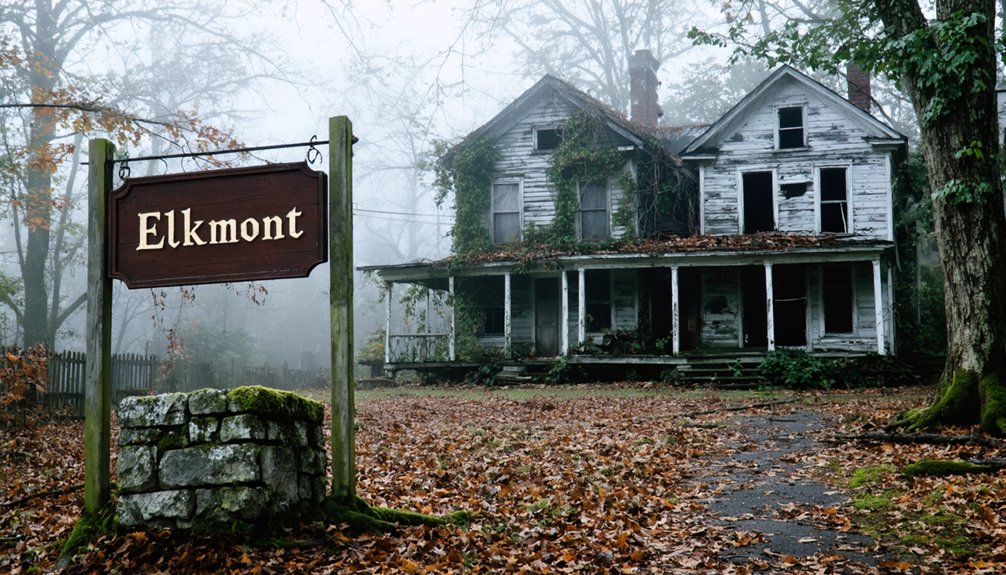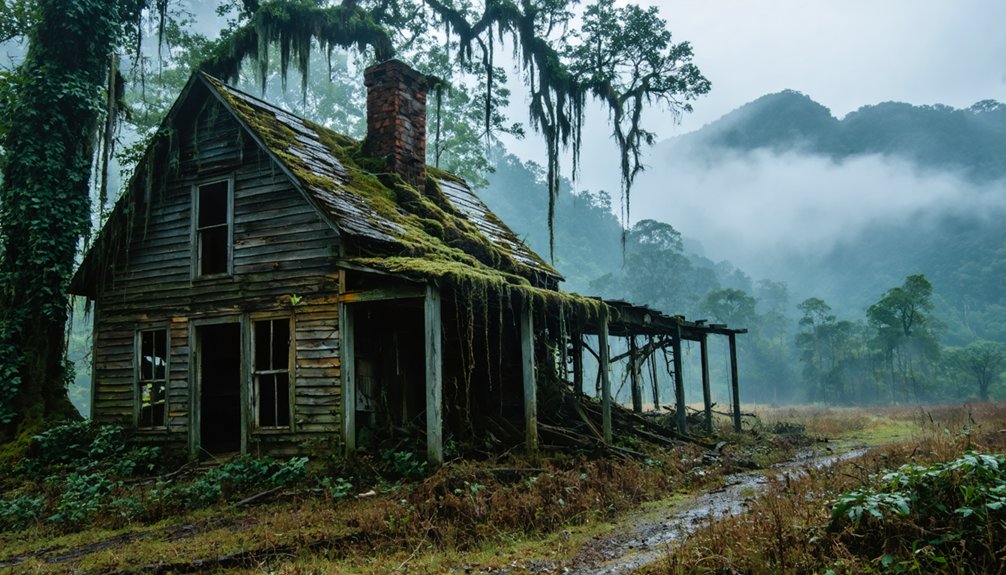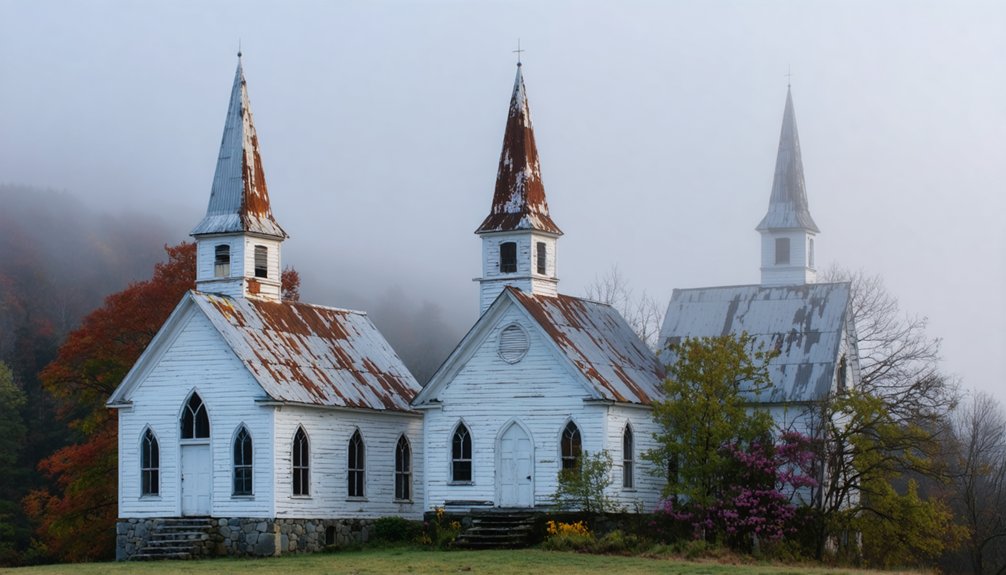To discover lost Appalachian ghost towns, start by researching historical maps and archives from 1850-1940. Pack essential gear including trekking poles and sturdy boots for traversing rugged terrain. Always verify the legal status of properties, as many abandoned sites remain privately owned. Capture photographs during golden hour to highlight architectural details and mountain settings. Connect with local historians and conservation groups who can provide access to oral histories and restricted areas. These connections reveal doorways to Appalachia’s forgotten past.
Key Takeaways
- Research historical maps, land deeds, and census records from 1850-1940 to identify abandoned settlements before exploring.
- Carry essential gear including topographic maps, compass, trekking poles, and first aid kit for safe ghost town exploration.
- Verify legal status of properties through title searches and obtain necessary permissions to avoid trespassing issues.
- Photograph ruins during golden hour, capturing both wide landscape shots and detailed artifacts for comprehensive documentation.
- Connect with local historians and conservation groups for access to oral histories and guidance to lesser-known sites.
Research Historical Maps and Documents Before You Go

Before commencing any expedition to discover lost Appalachian ghost towns, thorough research of historical maps and documents is essential to maximize your chances of success.
Start with OldMapsOnline and USGS topographic maps from the early 20th century, which reveal abandoned railroads, logging roads, and settlement locations with historical accuracy.
Historical maps unveil the hidden pathways to forgotten settlements, revealing where time has erased human presence.
Consult land deeds and census records (1850-1940) to identify original ownership patterns and population centers.
The Library of Congress and state archives in North Carolina, Tennessee, and Virginia offer extensive collections that require careful map interpretation.
Don’t overlook university libraries with regional history departments or local historical societies that maintain specialized collections.
Focus on finding founding dates, major families, and reasons for decline.
Many lost settlements like Lost Cove became known for moonshining operations due to their remote locations, which made them ideal for avoiding authorities.
Thurmond in West Virginia offers excellent historical preservation with many original buildings maintained by the National Park Service.
Remember that many sites now lie within protected lands or private property, requiring advance permission.
Essential Gear for Ghost Town Exploration in Rugged Terrain
Exploring abandoned settlements in the Appalachian wilderness requires specialized equipment that addresses both the challenges of rugged terrain and the unique demands of historical site investigation. Your pack should prioritize navigational tools like topographic maps specific to the Appalachian region and a compass for when GPS fails in dense forest canopies. Consider bringing trekking poles for additional stability when navigating steep, uneven terrain around abandoned structures.
Safety equipment including a first aid kit and personal locator beacon is non-negotiable when venturing into remote areas. A reliable sleeping pad will provide crucial comfort and insulation when camping near ghost town sites during overnight explorations.
- Sturdy hiking boots with ankle support to navigate crumbling foundations and overgrown pathways
- Headlamp with red-light mode for examining dark structures while preserving night vision
- Moisture-wicking layers that adapt to rapidly changing mountain weather conditions
- Water filtration system for accessing clean water from old settlement springs and streams
Understanding the Legal Status of Abandoned Properties

Charting the complex legal landscape of abandoned properties presents a critical challenge for ghost town explorers in the Appalachian region.
You’ll encounter sites with tangled ownership disputes resulting from multiple heirs, incomplete records, or unrecorded transfers. Before visiting, conduct thorough title searches to identify legitimate property owners and secure necessary permissions. Ghost Town Village’s history demonstrates how bankruptcy proceedings can create complex ownership situations spanning many years with multiple auction sales.
Be aware that many seemingly abandoned locations remain privately owned despite their condition. Some ghost towns have been acquired through eminent domain for national parks or conservation areas, changing their accessibility status.
Abandoned doesn’t mean unowned—these historic sites often maintain legal protections despite their weathered appearance.
Old places that appear to be abandoned are often important historical landmarks that reflect rural American lifestyle, particularly in Appalachian communities.
Others may be undergoing bankruptcy or foreclosure proceedings, complicating visitation rights.
Remember that trespassing laws apply regardless of a property’s abandoned appearance. Violations can result in significant penalties.
When in doubt, contact local historical societies or government offices for accurate information about legal access to these fascinating historical remnants.
Photography Tips for Capturing Appalachian Ruins
Photography of Appalachian ghost towns demands both technical skill and historical sensitivity to effectively document these vanishing cultural landscapes. Your equipment choices—tripods for stability and both wide-angle and telephoto lenses—will determine your compositional range and technical capabilities in these remote locations.
For compelling imagery that honors these forgotten places:
- Shoot during golden hour (early morning/late afternoon) when raking light accentuates weathered textures and creates dramatic shadows across abandoned structures.
- Frame wider contextual shots showing buildings within their mountain settings using natural elements as compositional anchors.
- Capture detail shots of artifacts—rusted tools, faded signage, weathered wood—that tell human stories.
- Experiment with black and white conversion to emphasize texture, form, and the timeless quality of these disappearing communities.
When photographing ghost towns, always conduct thorough pre-visit research to avoid trespassing on closed or private properties in these remote areas.
Mastering composition techniques and lighting strategies transforms documentation into artful preservation.
Consider including nearby cemeteries in your photographic journey as they often provide valuable historical context about the former residents and their way of life.
Connecting With Local Historians and Conservation Groups

While discovering abandoned towns can be enthralling on your own, forming strategic partnerships with local historians and conservation groups will greatly enhance your exploration of Appalachian ghost towns.
Local historians possess invaluable oral histories and unpublished narratives absent from official records. Establish connections through regional museums, libraries, or university history departments to access these resources and potentially participate in preservation efforts. These experts can guide you to towns like Thurmond and Kaymoor that represent significant pieces of Appalachian history.
Conservation organizations like the Southern Appalachian Highlands Conservancy protect historic sites while maintaining access trails. These groups offer volunteer opportunities that combine ecological stewardship with cultural heritage protection. Understanding the rich culture and history of these areas often requires guidance from those dedicated to preserving it.
Additionally, regional historical societies and archives house critical documentation—maps, photographs, and land deeds—that reconstruct the timelines of vanished communities. By engaging with these institutions, you’ll gain legal access to restricted areas and develop a more thorough understanding of these forgotten mountain settlements.
Frequently Asked Questions
Are There Seasonal Considerations for Exploring Appalachian Ghost Towns?
You’ll need to evaluate seasonal access limitations and weather conditions. Summer offers reliable exploration, while winter roads become impassable. Spring brings flooding risks, and fall provides stable conditions with colorful foliage.
How Dangerous Is Wildlife When Exploring Abandoned Mountain Communities?
Like untouched time capsules, abandoned communities harbor wildlife encounters ranging from mild to potentially fatal. You’ll face moderate danger if you’re unprepared, but practicing proper bear safety and respecting animal territories dramatically reduces risks.
What Paranormal Phenomena Are Commonly Reported in Appalachian Ghost Towns?
You’ll frequently encounter shadowy figures, temperature drops, disembodied voices, and moving objects. Haunting experiences often include spectral sightings of former residents, miners, and children in these abandoned communities.
Can I Legally Remove Artifacts From Abandoned Appalachian Settlements?
While you might desire to keep a piece of history, you can’t legally remove artifacts from abandoned settlements. Federal and state legal regulations strictly protect these sites, emphasizing artifact preservation over personal collection rights.
How Did Moonshining Operations Impact the Layout of Ghost Towns?
Moonshining operations shaped ghost towns through strategic settlement patterns centered around water sources, hidden terrain, and transportation corridors. You’ll notice moonshining routes influenced development of specialized infrastructure designed for quick escape and community protection.
References
- https://appalachian.org/lost-cove-ghost-town-in-the-national-forest/
- https://www.blueridgeoutdoors.com/go-outside/southern-ghost-towns/
- https://www.youtube.com/watch?v=4oHlJFXbrCk
- https://www.thewanderingappalachian.com/post/the-underwater-towns-of-appalachia
- https://appalachianmemories.org/2025/10/16/the-lost-towns-of-appalachia-the-forgotten-mountain-communities/
- https://www.geotab.com/ghost-towns/
- https://www.oldmapsonline.org/en/Appalachian_Mountains
- https://www.stio.com/blogs/hiking-gear/hiking-the-appalachian-trail-gear-list
- https://www.cinderstravels.com/appalachian-trail-gear/
- https://www.secrethike.com/post/appalachian-trail-full-thru-hike-gear-list



